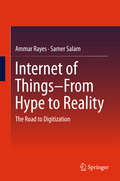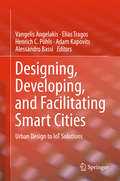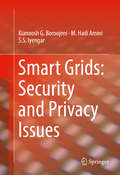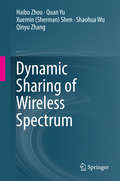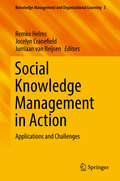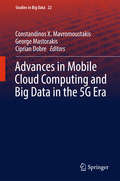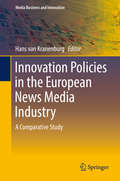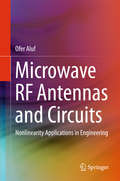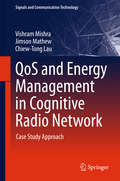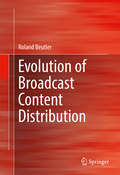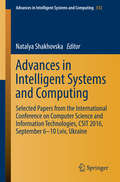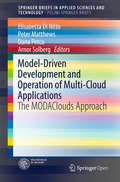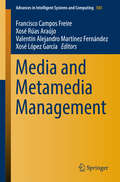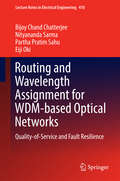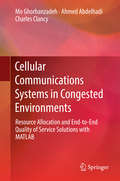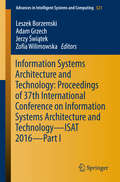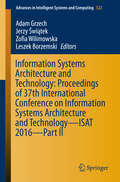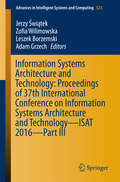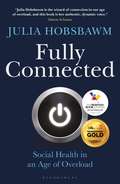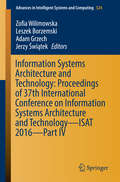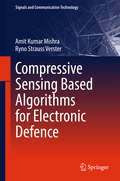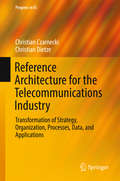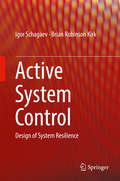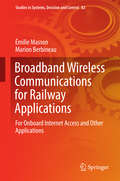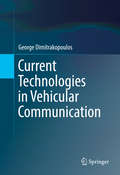- Table View
- List View
Internet of Things From Hype to Reality: The Road to Digitization
by Ammar Rayes Samer SalamThis book comprehensively describes an end-to-end Internet of Things (IoT) architecture that is comprised of devices, network, compute, storage, platform, applications along with management and security components. It is organized into five main parts, comprising of a total of 11 chapters. Part I presents a generic IoT reference model to establish a common vocabulary for IoT solutions. This includes a detailed description of the Internet protocol layers and the Things (sensors and actuators) as well as the key business drivers to realize the IoT vision. Part II focuses on the IoT requirements that impact networking protocols and provides a layer-by-layer walkthrough of the protocol stack with emphasis on industry progress and key gaps. Part III introduces the concept of Fog computing and describes the drivers for the technology, its constituent elements, and how it relates and differs from Cloud computing. Part IV discusses the IoT services platform, the cornerstone of the solution followed by the Security functions and requirements. Finally, Part V provides a treatment of the topic of connected ecosystems in IoT along with practical applications. It then surveys the latest IoT standards and discusses the pivotal role of open source in IoT. “Faculty will find well-crafted questions and answers at the end of each chapter, suitable for review and in classroom discussion topics. In addition, the material in the book can be used by engineers and technical leaders looking to gain a deep technical understanding of IoT, as well as by managers and business leaders looking to gain a competitive edge and understand innovation opportunities for the future.”Dr. Jim Spohrer, IBM “This text provides a very compelling study of the IoT space and achieves a very good balance between engineering/technology focus and business context. As such, it is highly-recommended for anyone interested in this rapidly-expanding field and will have broad appeal to a wide cross-section of readers, i.e., including engineering professionals, business analysts, university students, and professors.” Professor Nasir Ghani, University of South Florida
Designing, Developing, and Facilitating Smart Cities: Urban Design to IoT Solutions
by Vangelis Angelakis Elias Tragos Henrich C. Pöhls Adam Kapovits Alessandro BassiThis book discusses how smart cities strive to deploy and interconnect infrastructures and services to guarantee that authorities and citizens have access to reliable and global customized services. The book addresses the wide range of topics present in the design, development and running of smart cities, ranging from big data management, Internet of Things, and sustainable urban planning. The authors cover - from concept to practice – both the technical aspects of smart cities enabled primarily by the Internet of Things and the socio-economic motivations and impacts of smart city development. The reader will find smart city deployment motivations, technological enablers and solutions, as well as state of the art cases of smart city implementations and services.· Provides a single compendium of the technological, political, and social aspects of smart cities;· Discusses how the successful deployment of smart Cities requires a unified infrastructure to support the diverse set of applications that can be used towards urban development;· Addresses design, development and running of smart cities, including big data management and Internet of Things applications.
Smart Grids: Security and Privacy Issues
by Kianoosh G. Boroojeni M. Hadi Amini S. S. IyengarThis book provides a thorough treatment of privacy and security issues for researchers in the fields of smart grids, engineering, and computer science. It presents comprehensive insight to understanding the big picture of privacy and security challenges in both physical and information aspects of smart grids. The authors utilize an advanced interdisciplinary approach to address the existing security and privacy issues and propose legitimate countermeasures for each of them in the standpoint of both computing and electrical engineering. The proposed methods are theoretically proofed by mathematical tools and illustrated by real-world examples.
Dynamic Sharing of Wireless Spectrum
by Haibo Zhou Quan Yu Xuemin Sherman Shen Shaohua Wu Qinyu ZhangThis book focuses on the current research on the dynamic spectrum sharing for efficient spectrum resource utilization, which covers the overlay spectrum sharing, underlay spectrum sharing and database-assisted spectrum sharing related research issues. Followed by a comprehensive review and in-depth discussion of the current state-of-the-art research literature and industry standardization, this book first presents a novel overlay spectrum sharing framework for dynamic utilization of available cellular frequency bands, formulates the dynamic spectrum sharing problem as a dynamic resource demand-supply matching problem, and accordingly develops a distributed fast spectrum sharing algorithm to solve the resource matching problem. A self-awareness power control approach for multi-hop routing selection is proposed, which can establish an effective and practical routing selection optimization in secondary access networks and minimize the interference to primary users. Finally, this book offers dynamic secondary access scheme for database-assisted spectrum sharing networks, which is targeted to support the prosperous wireless multimedia networking applications by leveraging the TV white spaces of geolocation databases while satisfying QoS guarantees of secondary users. The overlay spectrum sharing, underlay spectrum sharing, and database-assisted white spaces spectrum sharing research results that are presented in this book provide useful insights for the design of next generation wireless access networks. This book motivates a new line of thinking for efficient spectrum resource utilization and performance enhancements of future wireless access applications.
Social Knowledge Management in Action: Applications and Challenges (Knowledge Management and Organizational Learning #3)
by Remko Helms Jocelyn Cranefield Jurriaan Van ReijsenKnowledge management (KM) is about managing the lifecycle of knowledge consisting of creating, storing, sharing and applying knowledge. Two main approaches towards KM are codification and personalization. The first focuses on capturing knowledge using technology and the latter on the process of socializing for sharing and creating knowledge. Social media are becoming very popular as individuals and also organizations learn how to use it. The primary applications of social media in a business context are marketing and recruitment. But there is also a huge potential for knowledge management in these organizations. For example, wikis can be used to collect organizational knowledge and social networking tools, which leads to exchanging new ideas and innovation. The interesting part of social media is that, by using them, one immediately starts to generate content that can be useful for the organization. Hence, they naturally combine the codification and personalisation approaches to KM. This book aims to provide an overview of new and innovative applications of social media and to report challenges that need to be solved. One example is the watering down of knowledge as a result of the use of organizational social media (Von Krogh, 2012).
Advances in Mobile Cloud Computing and Big Data in the 5G Era (Studies in Big Data #22)
by Constandinos X. Mavromoustakis George Mastorakis Ciprian DobreThis book reports on the latest advances on the theories, practices, standards and strategies that are related to the modern technology paradigms, the Mobile Cloud computing (MCC) and Big Data, as the pillars and their association with the emerging 5G mobile networks. The book includes 15 rigorously refereed chapters written by leading international researchers, providing the readers with technical and scientific information about various aspects of Big Data and Mobile Cloud Computing, from basic concepts to advanced findings, reporting the state-of-the-art on Big Data management. It demonstrates and discusses methods and practices to improve multi-source Big Data manipulation techniques, as well as the integration of resources availability through the 3As (Anywhere, Anything, Anytime) paradigm, using the 5G access technologies.
Innovation Policies in the European News Media Industry: A Comparative Study (Media Business and Innovation)
by Hans Van KranenburgThis book explores the importance and the types of media innovation policies formulated and implemented in various European countries. Each country analysis illustrates the evolution and structure of news media markets and media cross-ownership policies in recent years and evaluates how innovation policies stimulate innovative activities in journalism and news media. The main objective of this book is to promote discussion on how innovation policies can help the news media industry to meet development needs and requirements in the future. It will help scholars, politicians and practitioners in the media industry to identify best practices to support innovation in a rapidly changing news media landscape.
Microwave RF Antennas and Circuits: Nonlinearity Applications in Engineering
by Ofer AlufThis book describes a new concept for analyzing RF/microwave circuits, which includes RF/microwave antennas. The book is unique in its emphasis on practical and innovative microwave RF engineering applications. The analysis is based on nonlinear dynamics and chaos models and shows comprehensive benefits and results. All conceptual RF microwave circuits and antennas are innovative and can be broadly implemented in engineering applications. Given the dynamics of RF microwave circuits and antennas, they are suitable for use in a broad range of applications. The book presents analytical methods for microwave RF antennas and circuit analysis, concrete examples, and geometric examples. The analysis is developed systematically, starting with basic differential equations and their bifurcations, and subsequently moving on to fixed point analysis, limit cycles and their bifurcations. Engineering applications include microwave RF circuits and antennas in a variety of topological structures, RFID ICs and antennas, microstrips, circulators, cylindrical RF network antennas, Tunnel Diodes (TDs), bipolar transistors, field effect transistors (FETs), IMPATT amplifiers, Small Signal (SS) amplifiers, Bias-T circuits, PIN diode circuits, power amplifiers, oscillators, resonators, filters, N-turn antennas, dual spiral coil antennas, helix antennas, linear dipole and slot arrays, and hybrid translinear circuits. In each chapter, the concept is developed from the basic assumptions up to the final engineering outcomes. The scientific background is explained at basic and advanced levels and closely integrated with mathematical theory. The book also includes a wealth of examples, making it ideal for intermediate graduate level studies. It is aimed at electrical and electronic engineers, RF and microwave engineers, students and researchers in physics, and will also greatly benefit all engineers who have had no formal instruction in nonlinear dynamics, but who now desire to bridge the gap between innovative microwave RF circuits and antennas and advanced mathematical analysis methods.
QoS and Energy Management in Cognitive Radio Network: Case Study Approach (Signals and Communication Technology)
by Vishram Mishra Jimson Mathew Chiew-Tong LauThis book covers the important aspects involved in making cognitive radio devices portable, mobile and green, while also extending their service life. At the same time, it presents a variety of established theories and practices concerning cognitive radio from academia and industry. Cognitive radio can be utilized as a backbone communication medium for wireless devices. To effectively achieve its commercial application, various aspects of quality of service and energy management need to be addressed. The topics covered in the book include energy management and quality of service provisioning at Layer 2 of the protocol stack from the perspectives of medium access control, spectrum selection, and self-coexistence for cognitive radio networks.
Evolution of Broadcast Content Distribution
by Roland BeutlerThis book discusses opportunities for broadcasters that arise with the advent of broadband networks, both fixed and mobile. It discusses how the traditional way of distributing audio-visual content over broadcasting networks has been complemented by the usage of broadband networks. The author shows how this also gives the possibility to offer new types of interactive or so-called nonlinear services. The book illustrates how change in distribution technology is accelerating the need for broadcasters around the world to adapt their content distribution strategy and how it will impact the portfolios of content they offer.
Advances in Intelligent Systems and Computing: Selected Papers from the International Conference on Computer Science and Information Technologies, CSIT 2016, September 6-10 Lviv, Ukraine (Advances in Intelligent Systems and Computing #512)
by Natalya ShakhovskaThe book reports on new theories and applications in the field of intelligent systems and computing. It covers computational and artificial intelligence methods, as well as advances in computer vision, current issue in big data and cloud computing, computation linguistics, cyber-physical systems as well as topics in intelligent information management. Written by active researchers, the different chapters are based on contributions presented at the workshop in intelligent systems and computing (ISC), held during CSIT 2016, September 6-9, and jointly organized by the Lviv Polytechnic National University, Ukraine, the Kharkiv National University of Radio Electronics, Ukraine, and the Technical University of Lodz, Poland, under patronage of Ministry of Education and Science of Ukraine. All in all, the book provides academics and professionals with extensive information and a timely snapshot of the field of intelligent systems, and it is expected to foster new discussions and collaborations among different groups.
Model-Driven Development and Operation of Multi-Cloud Applications: The MODAClouds Approach (SpringerBriefs in Applied Sciences and Technology)
by Elisabetta Di Nitto Peter Matthews Dana Petcu Arnor SolbergThis books is open access under a CC BY 4.0 license.This book summarizes work being undertaken within the collaborative MODAClouds research project, which aims to facilitate interoperability between heterogeneous Cloud platforms and remove the constraints of deployment, portability, and reversibility for end users of Cloud services. Experts involved in the project provide a clear overview of the MODAClouds approach and explain how it operates in a variety of applications.While the wide spectrum of available Clouds constitutes a vibrant technical environment, many early-stage issues pose specific challenges from a software engineering perspective. MODAClouds will provide methods, a decision support system, and an open source IDE and run-time environment for the high-level design, early prototyping, semiautomatic code generation, and automatic deployment of applications on multiple Clouds. It will free developers from the need to commit to a fixed Cloud technology stack during software design and offer benefits in terms of cost savings, portability of applications and data between Clouds, reversibility (moving applications and data from Cloud to non-Cloud environments), risk management, quality assurance, and flexibility in the development process.
Media and Metamedia Management (Advances in Intelligent Systems and Computing #503)
by Francisco Campos Freire Xosé Rúas Araújo Valentín Alejandro Martínez Fernández Xosé López GarcíaMedia and Metamedia Management has contributions from seven prestigious experts, who offer their expertise and the view from their vantage point on communication, journalism, advertising, audiovisual, and corporate, political, and digital communication, paying special attention to the role of new technologies, the Internet and social networks, also from an ethics and legal dimension. A total of 118 authors belonging to 31 universities from Spain, Portugal, England and Ecuador have contributed to this book edited, coordinated and introduced by professors Francisco Campos-Freire and Xosé López-García, from the University of Santiago de Compostela, José Rúas-Araújo, from the University of Vigo, and Valentín A. Martínez-Fernández, from the University of A Coruña. Readers may also enjoy 66 articles, grouped into diverse chapters, on Journalism and cyberjournalism, audiovisual sector and media economy, corporate and institutional communication, and new media and metamedia.
Routing and Wavelength Assignment for WDM-based Optical Networks: Quality-of-Service and Fault Resilience (Lecture Notes in Electrical Engineering #410)
by Bijoy Chand Chatterjee Nityananda Sarma Partha Pratim Sahu Eiji OkiThis book presents an in-depth treatment of routing and wavelength assignment for optical networks, and focuses specifically on quality-of-service and fault resiliency issues. It reports on novel approaches for the development of routing and wavelength assignment schemes for fault-resilient optical networks, which improve their performance in terms of signal quality, call blocking, congestion level and reliability, without a substantial increase in network setup cost. The book first presents a solution for reducing the effect of the wavelength continuity constraint during the routing and wavelength assignment phase. Further, it reports on an approach allowing the incorporation of a traffic grooming mechanism with routing and wavelength assignment to enhance the effective channel utilization of a given capacity optical network using fewer electrical-optical-electrical conversions. As a third step, it addresses a quality of service provision scheme for wavelength-division multiplexing (WDM)-based optical networks. Lastly, the book describes the inclusion of a tree-based fault resilience scheme in priority-based dispersion-reduced wavelength assignment schemes for the purpose of improving network reliability, while maintaining a better utilization of network resources. Mainly intended for graduate students and researchers, the book provides them with extensive information on both fundamental and advanced technologies for routing and wavelength assignment in optical networks. The topics covered will also be of interest to network planners and designers.
Cellular Communications Systems in Congested Environments: Resource Allocation and End-to-End Quality of Service Solutions with MATLAB
by Mo Ghorbanzadeh Ahmed Abdelhadi Charles ClancyThis book presents a mathematical treatment of the radio resource allocation of modern cellular communications systems in contested environments. It focuses on fulfilling the quality of service requirements of the living applications on the user devices, which leverage the cellular system, and with attention to elevating the users’ quality of experience. The authors also address the congestion of the spectrum by allowing sharing with the band incumbents while providing with a quality-of-service-minded resource allocation in the network. The content is of particular interest to telecommunications scheduler experts in industry, communications applications academia, and graduate students whose paramount research deals with resource allocation and quality of service.
Information Systems Architecture and Technology: Proceedings Of 37th International Conference On Information Systems Architecture And Technology Isat 2016 Part I (Advances in Intelligent Systems and Computing #521)
by Leszek Borzemski Adam Grzech Jerzy Świątek Zofia WilimowskaThis four volume set of books constitutes the proceedings of the 2016 37th International Conference Information Systems Architecture and Technology (ISAT), or ISAT 2016 for short, held on September 18–20, 2016 in Karpacz, Poland. The conference was organized by the Department of Management Systems and the Department of Computer Science, Wrocław University of Science and Technology, Poland. The papers included in the proceedings have been subject to a thorough review process by highly qualified peer reviewers. The accepted papers have been grouped into four parts: Part I—addressing topics including, but not limited to, systems analysis and modeling, methods for managing complex planning environment and insights from Big Data research projects. Part II—discoursing about topics including, but not limited to, Web systems, computer networks, distributed computing, and mulit-agent systems and Internet of Things. Part III—discussing topics including, but not limited to, mobile and Service Oriented Architecture systems, high performance computing, cloud computing, knowledge discovery, data mining and knowledge based management. Part IV—dealing with topics including, but not limited to, finance, logistics and market problems, and artificial intelligence methods.
Information Systems Architecture and Technology: Proceedings of 37th International Conference on Information Systems Architecture and Technology – ISAT 2016 – Part II (Advances in Intelligent Systems and Computing #522)
by Adam Grzech Jerzy Świątek Zofia Wilimowska Leszek BorzemskiThis four volume set of books constitutes the proceedings of the 2016 37th International Conference Information Systems Architecture and Technology (ISAT), or ISAT 2016 for short, held on September 18–20, 2016 in Karpacz, Poland. The conference was organized by the Department of Management Systems and the Department of Computer Science, Wrocław University of Science and Technology, Poland. The papers included in the proceedings have been subject to a thorough review process by highly qualified peer reviewers. The accepted papers have been grouped into four parts: Part I—addressing topics including, but not limited to, systems analysis and modeling, methods for managing complex planning environment and insights from Big Data research projects. Part II—discoursing about topics including, but not limited to, Web systems, computer networks, distributed computing, and mulit-agent systems and Internet of Things. Part III—discussing topics including, but not limited to, mobile and Service Oriented Architecture systems, high performance computing, cloud computing, knowledge discovery, data mining and knowledge based management. Part IV—dealing with topics including, but not limited to, finance, logistics and market problems, and artificial intelligence methods.
Information Systems Architecture and Technology: Proceedings Of 37th International Conference On Information Systems Architecture And Technology - Isat 2016 Part Iii (Advances in Intelligent Systems and Computing #523)
by Jerzy Świątek Zofia Wilimowska Leszek Borzemski Adam GrzechThis four volume set of books constitutes the proceedings of the 2016 37th International Conference Information Systems Architecture and Technology (ISAT), or ISAT 2016 for short, held on September 18–20, 2016 in Karpacz, Poland. The conference was organized by the Department of Management Systems and the Department of Computer Science, Wrocław University of Science and Technology, Poland. The papers included in the proceedings have been subject to a thorough review process by highly qualified peer reviewers. The accepted papers have been grouped into four parts: Part I—addressing topics including, but not limited to, systems analysis and modeling, methods for managing complex planning environment and insights from Big Data research projects. Part II—discoursing about topics including, but not limited to, Web systems, computer networks, distributed computing, and mulit-agent systems and Internet of Things. Part III—discussing topics including, but not limited to, mobile and Service Oriented Architecture systems, high performance computing, cloud computing, knowledge discovery, data mining and knowledge based management. Part IV—dealing with topics including, but not limited to, finance, logistics and market problems, and artificial intelligence methods.
Fully Connected: Surviving and Thriving in an Age of Overload
by Julia HobsbawmShortlisted for the CMI's Management Book of the Year Award 2018 and the Business Book Awards 2018 Twenty-five years after the arrival of the Internet, we are drowning in data and deadlines. Humans and machines are in fully connected overdrive - and starting to become entwined as never before. Truly, it is an Age of Overload. We can never have imagined that absorbing so much information while trying to maintain a healthy balance in our personal and professional lives could feel so complex, dissatisfying and unproductive.Something is missing. That something, Julia Hobsbawm argues in this ground-breaking book, is Social Health, a new blueprint for modern connectedness. She begins with the premise that much of what we think about healthy ways to live have not been updated any more than have most post-war modern institutions, which are themselves also struggling in the twenty-first century. In 1946, the World Health Organization defined 'health' as 'a state of complete physical, mental and social well-being and not merely the absence of disease or infirmity.' What we understood by 'social' in the middle of the last century now desperately needs an update. In Fully Connected Julia Hobsbawm takes us on a journey – often a personal one, 'from Telex to Twitter' – to illustrate how the answer to the Age of Overload can come from devising management-based systems which are both highly practical and yet intuitive, and which draw inspiration from the huge advances the world has made in tackling other kinds of health, specifically nutrition, exercise, and mental well-being.Drawing on the latest thinking in health and behavioural economics, social psychology, neuroscience, management and social network analysis, this book provides a cornucopia of case studies and ideas, to educate and inspire a new generation of managers, policymakers and anyone wanting to navigate through the rough seas of overload.
Information Systems Architecture and Technology: Proceedings of 37th International Conference on Information Systems Architecture and Technology – ISAT 2016 – Part IV (Advances in Intelligent Systems and Computing #524)
by Zofia Wilimowska Leszek Borzemski Adam Grzech Jerzy ŚwiątekThis four volume set of books constitutes the proceedings of the 2016 37th International Conference Information Systems Architecture and Technology (ISAT), or ISAT 2016 for short, held on September 18–20, 2016 in Karpacz, Poland. The conference was organized by the Department of Management Systems and the Department of Computer Science, Wrocław University of Science and Technology, Poland. The papers included in the proceedings have been subject to a thorough review process by highly qualified peer reviewers. The accepted papers have been grouped into four parts: Part I—addressing topics including, but not limited to, systems analysis and modeling, methods for managing complex planning environment and insights from Big Data research projects. Part II—discoursing about topics including, but not limited to, Web systems, computer networks, distributed computing, and multi-agent systems and Internet of Things. Part III—discussing topics including, but not limited to, mobile and Service Oriented Architecture systems, high performance computing, cloud computing, knowledge discovery, data mining and knowledge based management. Part IV—dealing with topics including, but not limited to, finance, logistics and market problems, and artificial intelligence methods.
Compressive Sensing Based Algorithms for Electronic Defence (Signals and Communication Technology)
by Amit Kumar Mishra Ryno Strauss VersterThis book details some of the major developments in the implementation of compressive sensing in radio applications for electronic defense and warfare communication use. It provides a comprehensive background to the subject and at the same time describes some novel algorithms. It also investigates application value and performance-related parameters of compressive sensing in scenarios such as direction finding, spectrum monitoring, detection, and classification.
Reference Architecture for the Telecommunications Industry: Transformation of Strategy, Organization, Processes, Data, and Applications (Progress in IS)
by Christian Czarnecki Christian DietzeThis book reflects the tremendous changes in the telecommunications industry in the course of the past few decades – shorter innovation cycles, stiffer competition and new communication products. It analyzes the transformation of processes, applications and network technologies that are now expected to take place under enormous time pressure. The International Telecommunication Union (ITU) and the TM Forum have provided reference solutions that are broadly recognized and used throughout the value chain of the telecommunications industry, and which can be considered the de facto standard. The book describes how these reference solutions can be used in a practical context: it presents the latest insights into their development, highlights lessons learned from numerous international projects and combines them with well-founded research results in enterprise architecture management and reference modeling. The complete architectural transformation is explained, from the planning and set-up stage to the implementation. Featuring a wealth of examples and illustrations, the book offers a valuable resource for telecommunication professionals, enterprise architects and project managers alike.
Active System Control: Design of System Resilience
by Igor Schagaev Brian Robinson KirkThis book introduces an approach to active system control design and development to improve the properties of our technological systems. It extends concepts of control and data accumulation by explaining how the system model should be organized to improve the properties of the system under consideration. The authors define these properties as reliability, performance and energy-efficiency, and self-adaption. They describe how they bridge the gap between data accumulation and analysis in terms of interpolation with the real physical models when data used for interpretation of the system conditions. The authors introduce a principle of active system control and safety - an approach that explains what a model of a system should have, making computer systems more efficient, a crucial new concern in application domains such as safety critical, embedded and low-power autonomous systems like transport, healthcare, and other dynamic systems with moving substances and elements. On a theoretical level, this book further extends the concept of fault tolerance, introducing a system level of design for improving overall efficiency. On a practical level it illustrates how active system approach might help our systems be self-evolving.
Broadband Wireless Communications for Railway Applications: For Onboard Internet Access and Other Applications (Studies in Systems, Decision and Control #82)
by Émilie Masson Marion BerbineauThis book focuses on the needs of railway operators in terms of wireless communications, divided in two main categories: the commercial services and the operational needs. Then, all available technologies that can be used to provide Internet access on board trains and all the other operational applications requiring high capacity are detailed. Finally, challenges and trends in railway telecommunications are highlighted, through the presentation of the future and emerging technologies, the current discussions and works in the different authorities, and the key challenges and scientific barriers.
Current Technologies in Vehicular Communication
by George DimitrakopoulosThis book provides a concise and comprehensive overview of vehicular communication technologies. It classifies all relevant standards, protocols and applications, so as to enable the reader to gain a holistic approach towards the subject of vehicular communications. The primary methods are algorithmic processes and simulation results.First, an overview and classification of vehicular technologies is presented. Then, the book focuses on specific applications of V2V and V2I communications. Special attention is given to recent research and development results regarding R&D projects in the field, in cooperation with car manufacturing companies and universities at a global level.Designed to facilitate understanding of vehicle to vehicle and vehicle to infrastructure technologies, this textbook is appropriate for undergraduate and graduate students of vehicular communications or mobile networks.
